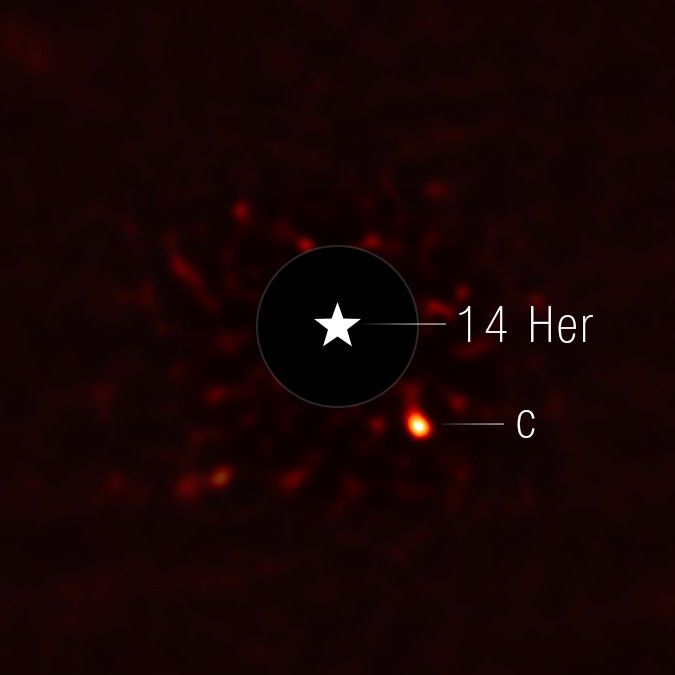The James Webb Space Telescope (JWST) has achieved another significant milestone by capturing a direct image of a distant, icy planet in a solar system that is very different from ours, as announced by astronomers on Tuesday (June 10).
This exoplanet, known as 14 Herculis c, or 14 Her c for short, revolves around a sun-like star located about 60 light-years away from Earth in the Hercules constellation. In the recent JWST image, it resembles a faint, blurry orange dot, with its color indicating heat radiating from its atmosphere converted into visible light.
Astronomers estimate that 14 Her c was formed approximately 4 billion years ago and has a very cold atmospheric temperature of about 26 degrees Fahrenheit (minus 3 degrees Celsius).
14 Her c orbits its star from a distance of roughly 1.4 billion miles (2.2 billion kilometers), which is about 15 times the distance from the Earth to the Sun. If it were placed in our solar system, it would be located between Saturn and Uranus.

In contrast to the orderly, flat orbits of the planets in our solar system, the 14 Herculis system has a notably disorganized structure. The two known planets, including 14 Her c, orbit at angles of around 40 degrees relative to each other, creating an “X”-shaped crossing pattern around their star.
This peculiar arrangement may have resulted from the early expulsion of a third large planet from the system, leading the remaining two into a chaotic gravitational “tug of war,” according to Balmer.
“These shifts appear to be stable over long periods,” he stated. “We are exploring the types of planet-to-planet interactions that could result in this unusual orbital configuration.”
This instability proved to be beneficial for Balmer’s research team. Out of nearly 6,000 known exoplanets, only a small number have been directly observed.
“This is quite a technical challenge,” said Balmer. Exoplanets shine thousands — and in some instances, even millions or billions — of times dimmer than their star counterparts, making them “like fireflies next to lighthouses,” he explained.
Most directly imaged exoplanets are warm, young gas giants that emit enough infrared light to contrast against the bright glare of their host stars. Conversely, cooler and older planets like 14 Her c are typically too dim to detect.
The planet’s tilted, irregular orbit, however, is “great news for direct imaging,” Balmer noted. “We could reliably predict that JWST could identify the outermost planet in the system.”
By employing the telescope’s specialized starlight-blocking tool known as a coronagraph, Balmer and his colleagues were able to isolate the planet’s faint infrared light.
“We are now able to expand our catalog to include older exoplanets that are considerably cooler than we have directly observed before Webb,” Balmer said in an announcement.
Considering 14 Her c’s estimated age of about 4 billion years, its mass of roughly seven times that of Jupiter, and computer simulations on planetary evolution, researchers anticipated the planet to be brighter — or radiate more heat — than it appears in the JWST image.
“The planet is actually much fainter than we expected,” Balmer remarked. “We don’t believe this is an issue with the evolutionary models, though.”
In examining the atmosphere of 14 Her c, JWST detected carbon dioxide and carbon monoxide at temperatures where methane would typically be found, suggesting that strong updrafts bring hot gases from deeper parts of the atmosphere to the cooler upper layers, Balmer explained. This phenomenon may be accompanied by thin icy clouds, which restrict heat escape into space and make the planet appear cooler and dimmer than expected.
With the discovery of 14 Her c, astronomers have widened the scope of exoplanets they can study. By investigating planets with various masses, temperatures, and orbital characteristics, scientists aim to enhance their understanding of how planetary systems, including our own, form and evolve.
“We seek to understand how these planets change, as this knowledge helps us comprehend our own origins,” Balmer concluded.


